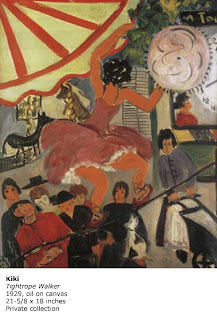Adopting a single name, "Kiki", she became a fixture in the Montparnasse social scene and a popular artist model, posing for dozens of artists, including Chaim Soutine, Tsuguharu Foujita, Francis Picabia, Jean Cocteau, Arno Breker, Alexander Calder, Per Krohg.
Her companion for most of the 1920s was Man Ray, who made hundreds of portraits of her. She is the subject of some of his best-known images, including the notable surrealist image Le violon d'Ingres and Noire et blanche.
She appeared in nine short and often experimental films, including 2-min La Retour a la Raison (1923) by Man Ray.
A painter in her own right, in 1927 Prin had a sold-out exhibition of her paintings at the Galerie au Sacre du Printemps in Paris. Signing her work with her chosen single name, Kiki, she usually noted the year. Her drawings and paintings comprise portraits, self-portraits, social activities, fanciful animals, and dreamy landscapes composed in a light, slightly uneven, expressionist style that is a reflection of her easy-going manner and boundless optimism.
A symbol of bohemian and creative Paris, at age of twenty-eight she was declared the Queen of Montparnasse. Even during difficult times, she maintained her positive attitude, saying "all I need is an onion, a bit of bread, and a bottle of red [wine]; and I will always find somebody to offer me that."
Prin died in 1953 in Sanary-sur-Mer, France at the age of fifty-one, apparently of complications of alcoholism or drug dependence. A large crowd of artists and fans attended her Paris funeral and followed the procession to her interment in the Cimetiere du Montparnasse. Her tomb identifies her as "Kiki, 1901–1953, singer, actress, painter, Queen of Montparnasse."






Brak komentarzy:
Prześlij komentarz